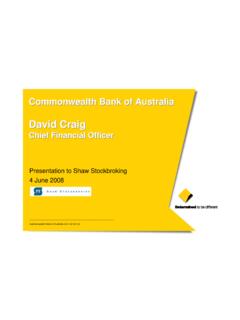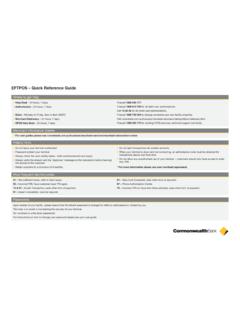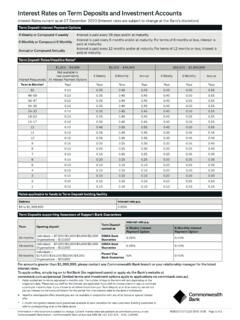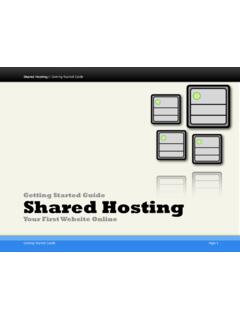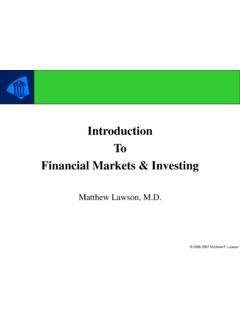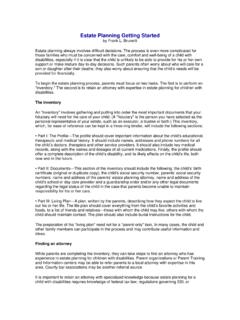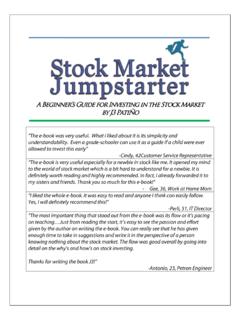Transcription of For individuals, companies, trusts and SMSFs The Options ...
1 OptionsFor individuals, companies, trusts and SMSFsThe Options and Lending Facility12 What are Options ?3 Ways to use Options7 getting started8 Frequently asked questions13 Contact us14 Important InformationContents2 Options are a versatile and powerful investment tool for experienced investors. With Options you can:potentially profit from either a rising or falling market by taking a directional position over selected Australian sharestake advantage of leverage, giving you the chance to reap profits with only a small initial outlay hedge your existing portfolio. The Commonwealth Bank offers Options on an over-the-counter (OTC) basis.
2 This means the Option is a private contract between the buyer and the seller, rather than traded through a stock exchange. One of the advantages of OTC Options is that the contract can be tailor-made for each transaction to suit the individual needs of each can invest? Options can be used by individuals, companies, trusts and self managed super funds (in some instances) to support a range of different investment features of OptionsSharesUp to 40 approved shares are availableTe r mMinimum investment term is three days and maximum investment term is five years, unless otherwise agreedOption styleEuropean and American (except Collar Options which are European style only)
3 Minimum amountMinimum value of an Option transaction is $50,000 based on the notional value of the transaction, unless otherwise agreedSettlementPhysical or cash (cash settlement must apply when the underlying share is CBA)What are Options ?3 Under The Options and Lending Facility you have access to:1. Call OptionsCall Options give the holder the right, but not the obligation, to buy an underlying share at a predetermined price (called the exercise price) on or before the expiry could consider Call Options if you wanted to:Call Option buyerCall Option sellerGain leveraged exposure to a share that you do not own but think will increase in priceGenerate additional income from a share you ownLock in a maximum purchase price for a share you are considering buyingSelling Call Options is not available to self managed super fundsExampleBHP Billiton (BHP)
4 shares are trading at $ John chooses to buy an American-style three month Call Option over 2,000 shares with an exercise price of $ As the buyer of this contract John has the right, but not the obligation, to buy 2,000 BHP shares for $ per share at any time until the expiry date. For this right, John pays a premium (or purchase price) to the seller of the Option, which in this case is Commonwealth Bank. To take up this right to buy the BHP shares at the specified price John must exercise the Option on or before the other hand the Commonwealth Bank as seller of this Call Option is obliged to deliver 2,000 BHP shares at $ per share if John exercises the Option.
5 For accepting this obligation the bank receives and keeps the Option premium whether the Option is exercised or OptionBuyer has the right to buy shares at the exercise price in return for paying the premium to the receives and keeps premium but now has the obligation to deliver shares if the buyer to use Options4 The characteristics for both the buyer and seller of a Call Option are summarised below:Call Option buyer Call Option sellerPays premiumReceives premiumRight to exercise and buy the sharesObligation to sell shares if exercisedBenefits from rising volatilityBenefits from time decayProfits from price risingProfits from price falling or remaining neutralLimited losses, potentially unlimited gainsPotentially unlimited losses, limited gainsCan sell before expiry to close outCan request to buy back before expiry or before assignment to close outSelling Call Options is not available to self managed super funds2.
6 Put OptionsPut Options give the holder the right, but not the obligation, to sell an underlying share at the exercise price on or before the expiry could consider Put Options if you wanted to:Put Option buyerPut Option sellerGain leveraged exposure to a share that you do not own but think will decrease in priceGenerate income from a share you do not necessarily ownReduce your risk of loss if the price of a share you own decreasesLock in a maximum purchase price for a share you are looking to buyExampleWoolworths Limited (WOW) shares are trading at $ Michelle chooses to buy an American-style three month Put Option over 5,000 shares with an exercise price of $ As the buyer of this contract Michelle has the right, but not the obligation, to sell 5,000 WOW shares for $ per share at any time until the expiry date.
7 For this right, Michelle pays a premium to the seller, being Commonwealth Bank. In order to take up this right to sell the WOW shares at the specified price, Michelle must exercise the Option on or before Commonwealth Bank is obliged to buy the WOW shares for $ per share if the Option is exercised. Like Call Options the seller of a Put Option receives and keeps the Option premium whether the Option is exercised or to use Options (cont.)BUYERPut OptionBuyer has the right to sell shares at the exercise price in return for paying the premium to the receives and keeps premium but now has the obligation to buy the underlying shares if the buyer characteristics for both the buyer and seller of a Put Option are summarised below.
8 Put Option buyer Put Option sellerPays premiumReceives premiumRight to exercise and sell the sharesObligation to buy shares if exercisedBenefits from rising volatilityBenefits from time decayProfits from price fallingProfits from price rising or remaining neutralLimited losses, potentially unlimited gainsPotentially unlimited losses, limited gainsCan sell before expiry to close outCan request to buy back before expiry or before assignment to close out63. Collar OptionsA Collar Option is a combination of a bought Put Option and a sold Call Option. It enables the holder to set a protection level for their shares , which reduces the impact of a large unexpected drop in share prices.
9 An upside cap is also set which means the holder will benefit from any share price gains up to this on where the protection level and cap is set, implementing a Collar Option may incur a cost to the holder, be zero cost or even result in an amount payable to the number of scenarios can occur at maturity:Method of settlementScenario 1 Final share price < protected priceScenario 2 Final share price 2 > protected price and < capped priceScenario 3 Final share price > capped priceCashKeep your shares and receive a cash settlement amountThe Collar Option expires worthless and you keep your sharesPay the cash settlement amount on the settlement datePhysicalSell your shares at the protected price on the settlement dateSell your shares at the capped price on the settlement dateCollar Options can only be brought, not sold.
10 Collar Options are not available to self managed super holds 20,000 shares in ANZ. He enters into the following Collar Option:ShareANZTe r m366 daysCurrent share price$ level$ (or 80% of current price)Cap level$ (or 120% of current price)Collar premium$ (Bill receives)Bill is protected if his shares fall below $ and he will enjoy the benefit of price rises up to $ Bill decide to diversify his share portfolio he can draw down the equity in his portfolio and apply for a loan (subject to credit approval). Bill can borrow a maximum amount that is equal to the protection level.

